人教版八年级下册英语Unit 2 I’ll help to clean up the city parks.语法讲练(含答案)
文档属性
| 名称 | 人教版八年级下册英语Unit 2 I’ll help to clean up the city parks.语法讲练(含答案) | 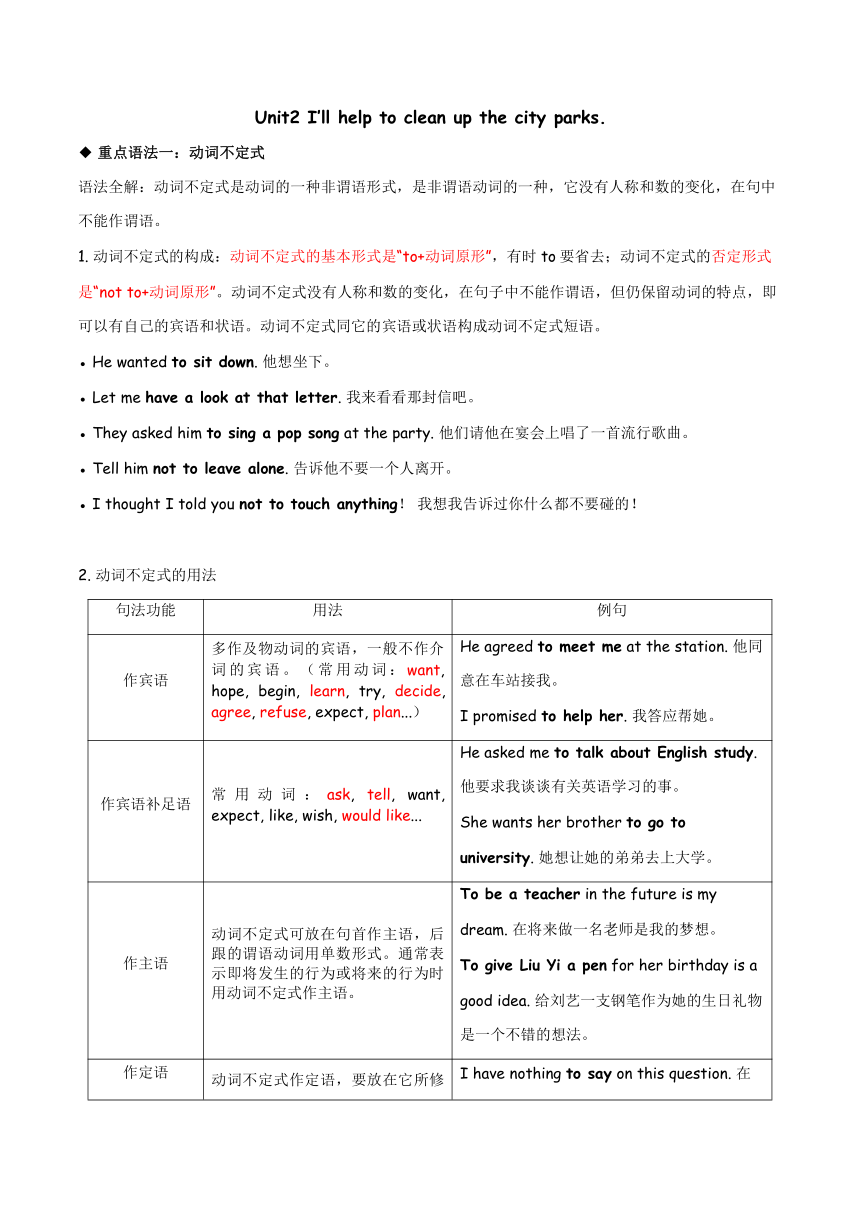 | |
| 格式 | zip | ||
| 文件大小 | 54.5KB | ||
| 资源类型 | 教案 | ||
| 版本资源 | 人教新目标(Go for it)版 | ||
| 科目 | 英语 | ||
| 更新时间 | 2020-05-16 10:09:46 | ||
图片预览

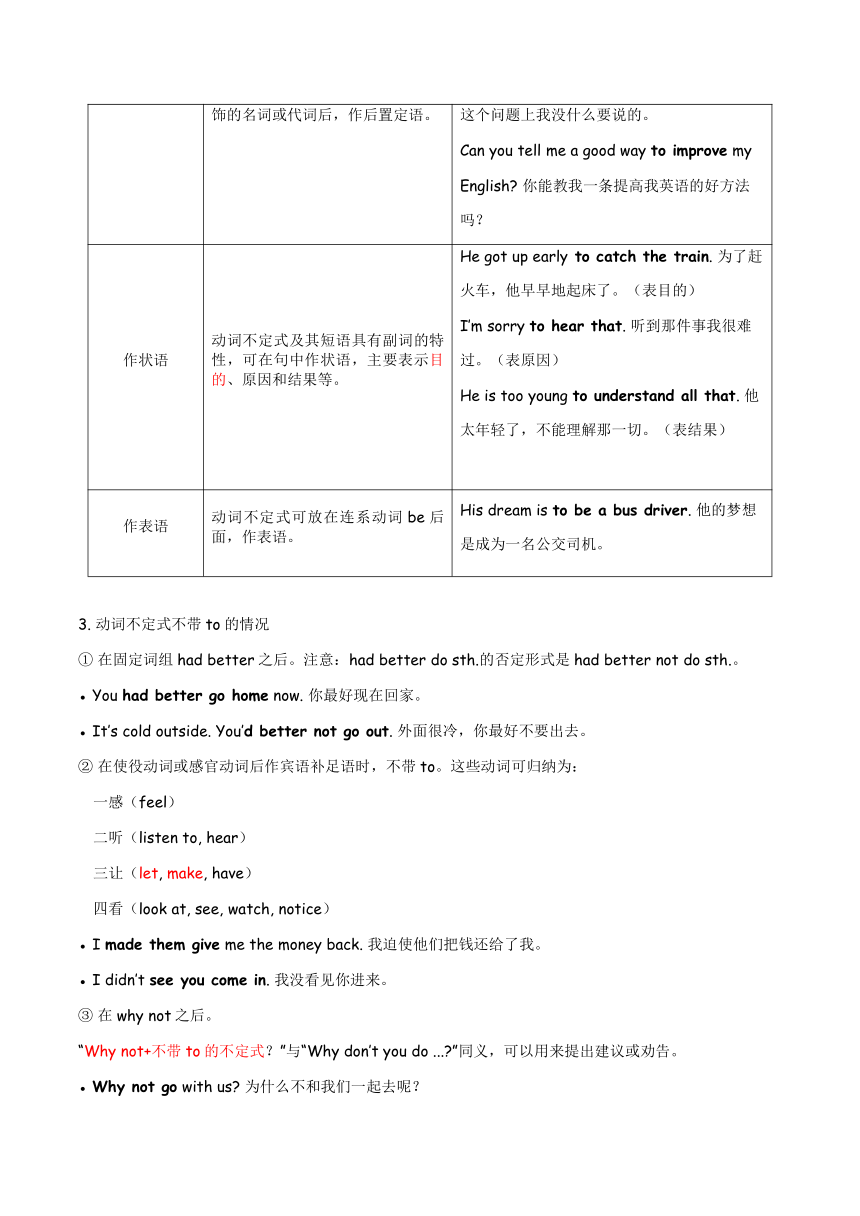
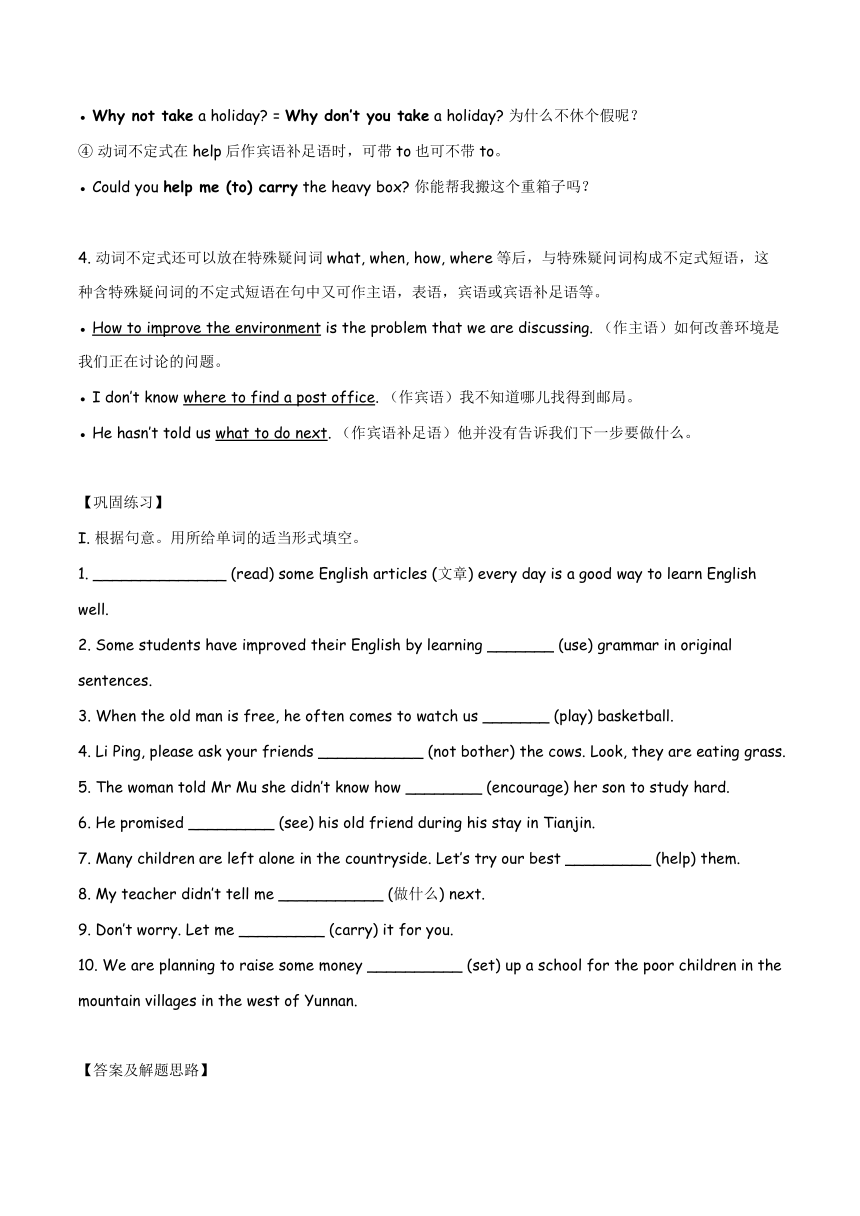
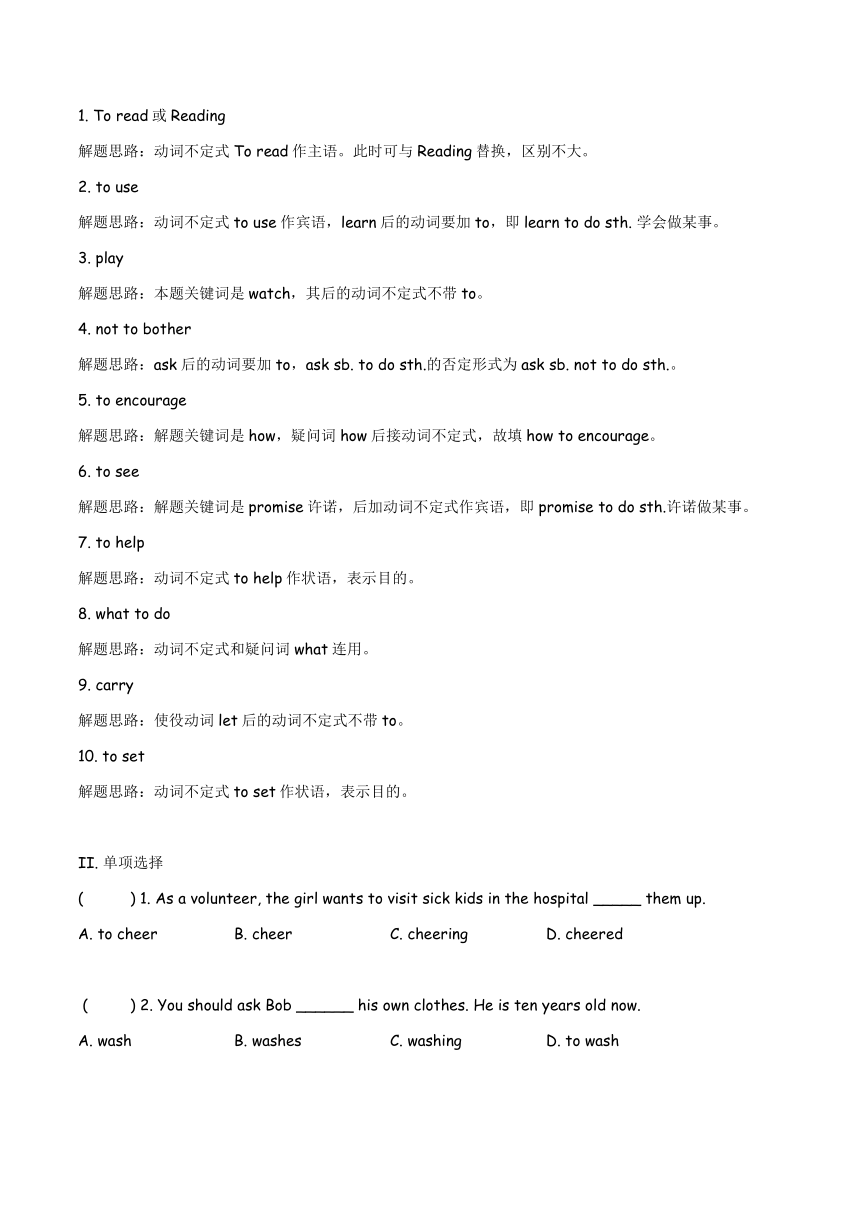
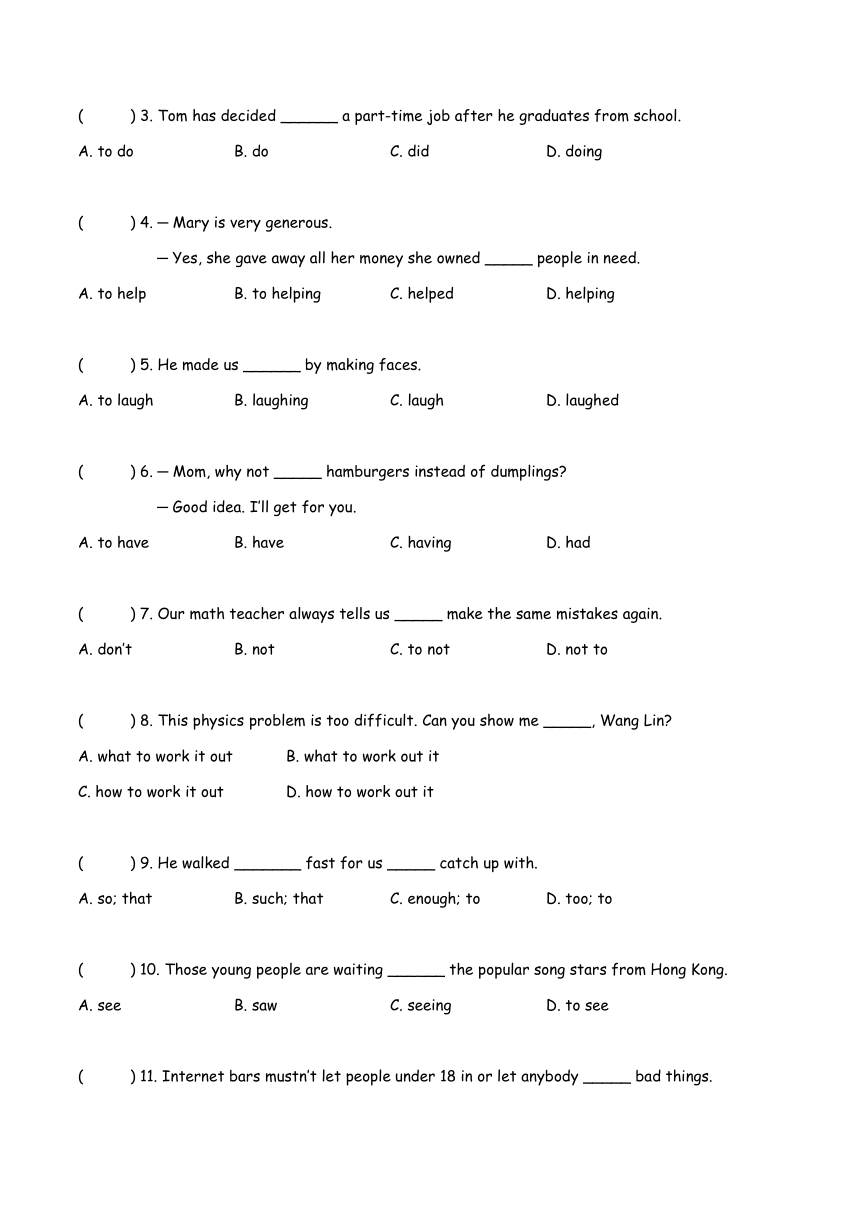
文档简介
Unit2 I’ll help to clean up the city parks.
◆ 重点语法一:动词不定式
语法全解:动词不定式是动词的一种非谓语形式,是非谓语动词的一种,它没有人称和数的变化,在句中
不能作谓语。
1. 动词不定式的构成:动词不定式的基本形式是“to+动词原形”,有时to要省去;动词不定式的否定形式
是“not to+动词原形”。动词不定式没有人称和数的变化,在句子中不能作谓语,但仍保留动词的特点,即
可以有自己的宾语和状语。动词不定式同它的宾语或状语构成动词不定式短语。
● He wanted to sit down. 他想坐下。
● Let me have a look at that letter. 我来看看那封信吧。
● They asked him to sing a pop song at the party. 他们请他在宴会上唱了一首流行歌曲。
● Tell him not to leave alone. 告诉他不要一个人离开。
● I thought I told you not to touch anything! 我想我告诉过你什么都不要碰的!
2. 动词不定式的用法
句法功能 用法 例句
作宾语 多作及物动词的宾语,一般不作介词的宾语。(常用动词:want, hope, begin, learn, try, decide, agree, refuse, expect, plan...) He agreed to meet me at the station. 他同意在车站接我。I promised to help her. 我答应帮她。
作宾语补足语 常用动词:ask, tell, want, expect, like, wish, would like... He asked me to talk about English study. 他要求我谈谈有关英语学习的事。She wants her brother to go to university. 她想让她的弟弟去上大学。
作主语 动词不定式可放在句首作主语,后跟的谓语动词用单数形式。通常表示即将发生的行为或将来的行为时用动词不定式作主语。 To be a teacher in the future is my dream. 在将来做一名老师是我的梦想。To give Liu Yi a pen for her birthday is a good idea. 给刘艺一支钢笔作为她的生日礼物是一个不错的想法。
作定语 动词不定式作定语,要放在它所修饰的名词或代词后,作后置定语。 I have nothing to say on this question. 在这个问题上我没什么要说的。Can you tell me a good way to improve my English? 你能教我一条提高我英语的好方法吗?
作状语 动词不定式及其短语具有副词的特性,可在句中作状语,主要表示目的、原因和结果等。 He got up early to catch the train. 为了赶火车,他早早地起床了。(表目的)I’m sorry to hear that. 听到那件事我很难过。(表原因)He is too young to understand all that. 他太年轻了,不能理解那一切。(表结果)
作表语 动词不定式可放在连系动词be后面,作表语。 His dream is to be a bus driver. 他的梦想是成为一名公交司机。
3. 动词不定式不带to的情况
① 在固定词组had better之后。注意:had better do sth.的否定形式是had better not do sth.。
● You had better go home now. 你最好现在回家。
● It’s cold outside. You’d better not go out. 外面很冷,你最好不要出去。
② 在使役动词或感官动词后作宾语补足语时,不带to。这些动词可归纳为:
一感(feel)
二听(listen to, hear)
三让(let, make, have)
四看(look at, see, watch, notice)
● I made them give me the money back. 我迫使他们把钱还给了我。
● I didn’t see you come in. 我没看见你进来。
③ 在why not之后。
“Why not+不带to的不定式?”与“Why don’t you do ...?”同义,可以用来提出建议或劝告。
● Why not go with us? 为什么不和我们一起去呢?
● Why not take a holiday? = Why don’t you take a holiday? 为什么不休个假呢?
④ 动词不定式在help后作宾语补足语时,可带to也可不带to。
● Could you help me (to) carry the heavy box? 你能帮我搬这个重箱子吗?
4. 动词不定式还可以放在特殊疑问词what, when, how, where等后,与特殊疑问词构成不定式短语,这
种含特殊疑问词的不定式短语在句中又可作主语,表语,宾语或宾语补足语等。
● How to improve the environment is the problem that we are discussing. (作主语)如何改善环境是
我们正在讨论的问题。
● I don’t know where to find a post office. (作宾语)我不知道哪儿找得到邮局。
● He hasn’t told us what to do next. (作宾语补足语)他并没有告诉我们下一步要做什么。
【巩固练习】
I. 根据句意。用所给单词的适当形式填空。
1. ______________ (read) some English articles (文章) every day is a good way to learn English
well.
2. Some students have improved their English by learning _______ (use) grammar in original
sentences.
3. When the old man is free, he often comes to watch us _______ (play) basketball.
4. Li Ping, please ask your friends ___________ (not bother) the cows. Look, they are eating grass.
5. The woman told Mr Mu she didn’t know how ________ (encourage) her son to study hard.
6. He promised _________ (see) his old friend during his stay in Tianjin.
7. Many children are left alone in the countryside. Let’s try our best _________ (help) them.
8. My teacher didn’t tell me ___________ (做什么) next.
9. Don’t worry. Let me _________ (carry) it for you.
10. We are planning to raise some money __________ (set) up a school for the poor children in the
mountain villages in the west of Yunnan.
【答案及解题思路】
1. To read或Reading
解题思路:动词不定式To read作主语。此时可与Reading替换,区别不大。
2. to use
解题思路:动词不定式to use作宾语,learn后的动词要加to,即learn to do sth. 学会做某事。
3. play
解题思路:本题关键词是watch,其后的动词不定式不带to。
4. not to bother
解题思路:ask后的动词要加to,ask sb. to do sth.的否定形式为ask sb. not to do sth.。
5. to encourage
解题思路:解题关键词是how,疑问词how后接动词不定式,故填how to encourage。
6. to see
解题思路:解题关键词是promise许诺,后加动词不定式作宾语,即promise to do sth.许诺做某事。
7. to help
解题思路:动词不定式to help作状语,表示目的。
8. what to do
解题思路:动词不定式和疑问词what连用。
9. carry
解题思路:使役动词let后的动词不定式不带to。
10. to set
解题思路:动词不定式to set作状语,表示目的。
II. 单项选择
( ) 1. As a volunteer, the girl wants to visit sick kids in the hospital _____ them up.
A. to cheer B. cheer C. cheering D. cheered
( ) 2. You should ask Bob ______ his own clothes. He is ten years old now.
A. wash B. washes C. washing D. to wash
( ) 3. Tom has decided ______ a part-time job after he graduates from school.
A. to do B. do C. did D. doing
( ) 4. ─ Mary is very generous.
─ Yes, she gave away all her money she owned _____ people in need.
A. to help B. to helping C. helped D. helping
( ) 5. He made us ______ by making faces.
A. to laugh B. laughing C. laugh D. laughed
( ) 6. ─ Mom, why not _____ hamburgers instead of dumplings?
─ Good idea. I’ll get for you.
A. to have B. have C. having D. had
( ) 7. Our math teacher always tells us _____ make the same mistakes again.
A. don’t B. not C. to not D. not to
( ) 8. This physics problem is too difficult. Can you show me _____, Wang Lin?
A. what to work it out B. what to work out it
C. how to work it out D. how to work out it
( ) 9. He walked _______ fast for us _____ catch up with.
A. so; that B. such; that C. enough; to D. too; to
( ) 10. Those young people are waiting ______ the popular song stars from Hong Kong.
A. see B. saw C. seeing D. to see
( ) 11. Internet bars mustn’t let people under 18 in or let anybody _____ bad things.
A. watch B. to watch C. watching D. watches
( ) 12. The students of Class One will spend their winter holiday in Shenzhen, but the
students of Class Two haven’t decided _________.
A. what to buy B. how to go C. where to go D. which to choose
( ) 13. He raised his voice to make everybody in the room ______ him clearly.
A. heard B. hear C. to hear D. hearing
( ) 14. After the PE class, the teacher offered us something ________.
A. drink B. drinking C. drunk D. to drink
( ) 15. The chemistry problem is rather difficult for me. I’ve thought about it for a long time,
but I still don’t know __________.
A. what to do B. how to do C. what to deal with D. how to deal with
【答案及解题思路】
1. 答案:A
解题思路:设空处“to cheer them up使他们高兴”是女孩去探望生病儿童的目的。
2. 答案:D
解题思路:此题解题关键词是“ask让”,ask后加动词不定式to do形式作宾语补足语。
3. 答案:A
解题思路:此题解题关键词是“decide决定”,decide后加动词不定式to do形式作宾语。
4. 答案:A
解题思路:设空处“to help people帮助人们”是Mary捐钱的目的。
5. 答案:C
解题思路:此题解题关键词是“make(made)使”,make后加不带to的动词不定式形式作宾语补足语。
6. 答案:B
解题思路:why not意为“为什么不……”,后加不带to的动词不定式,构成“why not do sth.为什么
不做某事”。
7. 答案:D
解题思路:此题解题关键词是“tell告诉”,tell后加动词不定式to do形式作宾语补足语,否定形式为
“tell sb. not to do sth.告诉某人不要做某事”。
8. 答案:C
解题思路:询问解题的方法,应该用疑问词how,故排除A项和B项。work out意为“算出;解决出”,
是“动词+副词”形式的短语动词,当其宾语为代词it时,it应放在动词和副词之间。
9. 答案:D
解题思路:A项so ... that ... 意为“如此……以致于……”,that后接从句,故排除。B项such ...that...
意为“如此……以致于……”,such后接名词,故排除。C项enough意为“足够的……”,不符合句意,
故排除。D项too ... to ... 意为“太……以致于不能……”,符合句意。
10. 答案:D
解题思路:设空处“to see the popular song stars见流行歌曲明星们”是年轻人等待的目的。
11. 答案:A
解题思路:此题解题关键词是“let让”,let是使役动词,后加不带to的动词不定式作宾语补足语。
12. 答案:C
解题思路:根据句意疑问词应用where。
13. 答案:C
解题思路:此题解题关键词是“make(made)使”,make后加不带to的动词不定式形式作宾语补足语。
14. 答案:D
解题思路:考查不定式作定语,设空处“to drink”作后置定语修饰前面的something。
15. 答案:A
解题思路:B项how to do后应有宾语,故排除。C项和D项,deal with意为“处理”,后面也应该接宾
语,故排除。A项what to do中,what即为do的宾语,故其后不用接宾语。
◆ 重点语法二:短语动词
语法全解:由动词加介词、副词或其他词构成的相当于一个动词作用的词组称为短语动词。有些短语动词相当于及物动词,有些则相当于不及物动词。短语动词的构成可分为以下六种基本类型:
1. 动词+副词
①“动词+副词”相当于不及物动词
此时该短语动词在句中直接作谓语,其后不加任何宾语。常用的此类副词有away,along,back,
down,in,off,on,out,up等。
break out 爆发 break up 分解 come up 出现
fall behind 落后 get along 进展 get up 起床
give in 屈服 grow up 长大 hold on 等一会儿
● A quarrel broke out between them. 他们间爆发了一场争吵。
● He came up and introduced himself. 他走上前来并作了自我介绍。
● She grew up in Tokyo. 她在东京长大。
② “动词+副词”相当于及物动词
有的“动词+副词”相当于及物动词,后接宾语时,宾语如果是人称代词的宾格形式,需将其放在动
词和副词之间;如果是名词或nothing,everything等不定代词时,则可以放在动词和副词之间,也
可以放在副词后面。
find out 查明,查出 hold up 举起;支持 put on 穿上;上演
put out 熄灭 put up 建造;张贴 pick up 捡起;接某人
turn off 关闭 turn down 调小 turn on 打开
● Can you turn down the music, please? = Can you turn the music down, please? = Can you turn
it down, please? 请你把音乐关小好吗?
注意:Can you turn down it, please? 是错误说法。
● She picked the pen up and gave it back to me. = She picked up the pen and gave it back to
me. 她捡起钢笔并把它还给了我。
2. 动词+介词
“动词+介词”结构相当于及物动词,其后需要带宾语,而且无论宾语是名词还是人称代词都要放在介
词的后面。常用的此类介词有for,about,over,after,into,at,to,on,across,with等。
break into 破门而入 care for 喜欢;照顾 come across 偶然碰见
laugh at 嘲笑 look after 照顾 look into 调查
look for 寻找 stand for 代表 wait for 等候
● There?was?no?one?nearby?who?might?see?him?trying?to?break?into?the?house. 附近没有人可能会
看见他试图闯入房子里。
● I?had?a?strong?desire?to?help?and?care?for?people. 我非常渴望能够帮助和照顾他人。
● I?walk?to?a?street?corner?and?wait?for?the?school?bus. 我走到街角等校车。
3. 动词+副词+介词
在这类短语动词中,动词、副词、介词紧密结合,已成为一体,词义上相当于一个及物动词,所带的
宾语总是位于介词之后。
run out of 用光 get out of 离开 come up with 想出
catch up with 赶上 look forward to 盼望 go on with 继续
● Who came up with the good idea? 谁想出了这个好主意?
● I?now?look?forward?to?going?back?to?work?as?soon?as?possible.?我现在渴望尽早回到工作岗位。
4. 动词+名词
这类短语动词中常见的动词有have,take,give,make等。
have a rest 休息一下 take a walk 散步 make mistakes 犯错
have a try 试一下 take place 发生 tell a lie 撒谎
● You look tired and you should have a rest. 你看起来很疲惫,应该休息一下。
5. 动词+名词+介词
这类短语动词只用作及物动词。名词前可加形容词说明程度;宾语总是位于介词之后。
have a look at 看一看 make friends with 与……交朋友 pay attention to 注意
make fun of 取笑 take care of 照顾
● You should pay attention to your teacher in class. 在课堂上你应该注意听老师讲课。
6. be+形容词(包括过去分词作形容词)+介词
这类短语动词也相当于及物动词,宾语位于介词的后面,形容词是短语动词的真正词义。
be late for 迟到 be busy with 忙于 be worried about 担心
be fond of 喜爱 be good at 擅长 be good / bad for 对……有益/有害
be short of 缺乏 be similar to 与……相似 be strict with 对……严格要求
be proud of 为……骄傲 be different from 与……不同
● Eating more vegetables and fruit is good for your health. 多吃蔬菜和水果对你的健康有好处。
【巩固练习】
( ) 1. ─ Mum, where are my socks?
─ Under your bed. You should _____ your things.
A. put on B. put down C. put away D. put up
( ) 2. ─ How heavily it is raining!
─ What a pity! We have to _____ our sports meeting.
A. put off B. put out C. put on D. put up
( ) 3. Many teenagers ______ the old and they often offer their seats to the old on buses.
A. agree with B. worry about C. laugh at D. care for
( ) 4. Although many great people ever failed, they never _____ and managed to succeed.
A. set out B. stayed up C. kept on D. gave up
( ) 5. If Ted can ______ his difficulties, he’ll make great progress.
A. come over B. get over C. get off D. come out
( ) 6. ─ Could you please teach me how to _____ “red envelope”(红包) on WeChat?
─ Sure. Let me show you.
A. give away B. give up C. give back D. give out
( ) 7. Your toys are here and there. Please _____, Linda.
A. put away them B. put them away C. put them out D. put up them
( ) 8. My best friend Mario failed in the math competition. I’d like to _______.
A. dress him up B. pick him up C. cheer him up D. take him up
( ) 9. ─ The girl ____ all her pocket money to the people whose houses were destroyed by
the earthquake.
─ What a kind girl!
A. took away B. gave up C. gave away D. put away
( ) 10. ─ You have really beautiful blue eyes.
─ Thank you. I ______ my mother.
A. look after B. take after C. take from D. look for
【答案及解题思路】
1. 答案:C
解题思路:put on 上演;穿上。put down放下。put away收拾好。put up举起;张贴;搭建。
2. 答案:A
解题思路:put off 推迟。put out熄灭。put on穿上;上演。put up举起;张贴;搭建。
3. 答案:D
解题思路:agree with 同意。worry about担心,担忧。laugh at 嘲笑。care for关心。
4. 答案:D
解题思路:set out 出发。stay up熬夜。keep on 继续。give up放弃。
5. 答案:B
解题思路:come over 顺便来访。get over克服。get off 下车。come out出现。
6. 答案:D
解题思路:give away 捐赠;泄露。give up放弃。give back 归还。give out分发。
7. 答案:B
解题思路:put away 收拾好。put out熄灭。put up 举起;张贴。them应放在put和away之间。
8. 答案:C
解题思路:dress up 打扮。pick up捡起;接某人。cheer up 高兴起来。take up拿起;占用。
9. 答案:C
解题思路:take away 拿走。give up放弃。give away捐赠;泄露。put away收拾好。
10. 答案:B
解题思路:look after 照顾。take after长得像。take from从……拿。look for寻找。
同课章节目录
- Unit 1 What's the matter?
- Section A
- Section B
- Unit 2 I'll help to clean up the city parks.
- Section A
- Section B
- Unit 3 Could you please clean your room?
- Section A
- Section B
- Unit 4 Why don't you talk to your parents?
- Section A
- Section B
- Unit 5 What were you doing when the rainstorm came
- Section A
- Section B
- Review of Units 1-5
- Unit 6 An old man tried to move the mountains.
- Section A
- Section B
- Unit 7 What's the highest mountain in the world?
- Section A
- Section B
- Unit 8 Have you read Treasure Island yet?
- Section A
- Section B
- Unit 9 Have you ever been to a museum?
- Section A
- Section B
- Unit 10 I've had this bike for three years.
- Section A
- Section B
